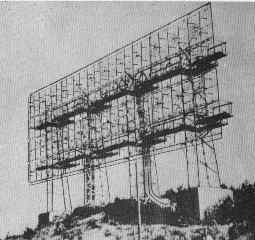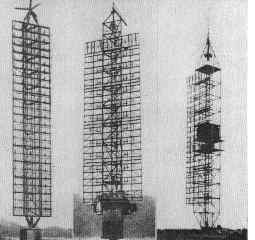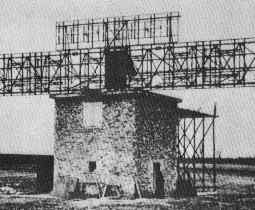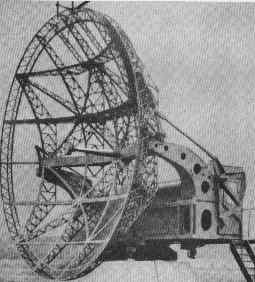Development work on German radar sets used during the second world
war was largely begun in the 1930s. With their faith pinned to a short
war, the Germans early standardized design. The result was that most German
radar sets were gun-laying systems, converted to search and aircraft interception
work. Their radar all operated on long or medium wave ( 2.6 m to 53 cm).
The Germans themselves did not develop any useful microwave techniques.
All radar research was curtailed about 1939 in favor of intensive development
along limited lines, and microwaves received no attention until the capture
in the spring of 1943 of the British 10-cm H2S set. The Germans soon made
copies of the magnetron, which, however, did not give as high power as
the original. Although copies of the H2S ( called Rotterdamgerät )
were made, the Germans felt it necessary to shorten the display tube (
Berlingerät ), and no sets were ever used. The capture of the American
3-cm H2X resulted in the exact copy known as : Meddgerät: some ten
of these were built by 1945 for installation in fast-flying aircraft for
the bombing of London. but seem never to have been used.
Ground Air Force Equipment
The basic ground equipment of the German Air Force consisted of the Freya,
a long-wave aircraft reporting set built bv Gama, and introduced in 1939,
and the Würzburg, used chiefly for intercept control, built by Telefunken
and first introduced into service in 1940. Their most important use was
as GCI (ground control of interception) stations. though they had some
early use as gun-laying sets.
There were two types of Freya. the "Limber" type, a mobile set
built on a flak mounting, introduced in 1939, and the "Pole";
transportable type, introduced in I941. Both these sets operated on a wavelength
of 2.1 to 2.6 m and gave range and azimuth, but not elevation. The Freya
seems to have been developed from naval gun-laying equipment, and was,
therefore, very ruggedly built and more accurate ( 100 m in range, lo bearing,
0.2o relative bearing) than was required for its later jobs of early warning
and aircraft reporting. Its maximum range was 120 miles. Freya was often
provided with "Spilt";. a lobe switching device which gave a
presentation of two blips on either side of a vertical line. When the target
was dead ahead the two blips were of equal size; otherwise, the blip on
the side toward the target was larger. Somewhat similar to the Freya, but
with larger antennas and greater maximum range (about 160 miles ) wese
the Hoarding ( Mammut ) and Chimney ( Wassermann ), named from the appearance
of the antennas. These sets were in use by 1942. The Freya was initially
used for searchlight eontrol, but this use was abandoned in 1942.
The various Würzburg sets were the backbone of the GCI stations, though
they were at first used only for flak control. Development began on the
Würzburg in 1936, and the Würzburg A was in service by 1940.
It was followed a year later by the Würzburg C and the Giant Würzburg,
which had a parabolic antenna 8 m in diameter. These sets, which operated
on 53 cm ( also 63 in the case of the Würzburg C ) gave height as
well as range and bearing. Their maximum range was not great ( 24 miles
for the A and C models, 48 for the Giant ) but their accuracy was good
( 0.2o in bearing and elevation,125 m in range).
The Germans set up early an elaborate GCI system, covering all approaches
to Germany. Each station covered an assigned area ( "box" ) ;
the stations were 20 to 40 miles apart. When bombers were detected, a night
fighter was ordered up; the fighter homed on a visual or radio beacon until
the GCI station ordered the intercept. The fighter was then directed by
radar to the intercept, and was controlled until he sighted the bomber
visually or, later, by AI radar. At first the bomber and fighter were followed
by Freya, sometimes with a Würzburg set to give height; the Freya
followed the bomber and fighter alternately, and a course predictor permitted
continual following of both planes on the plotting table. Later, with the
increased availability of Giant Würzburgs, the Freya was used only
for early warning, and for general search. When Giant Würzburgs were
used, as became increasingly the custom, two sets were required, one to
follow the fighter and one the bomber. The fighter Würzburg received
recognition signals from the fighter's IFF-the FuGe 25. (There was also
an FuGe 25A which provided recognition signals for Freya. ) This system
seems to have been quite efficient, except when the bombers flew the boundary
between "boxes", when valuable time was lost in determining which
GCI station should take control.
Navy Equipment
The most important of the German naval equipment was the system of coastwatcher
(Seetakt) which protected the north coast of France. Originally the 80-cm
Gama Coastwatcher was used, but by 1944 the 53-cm Würzburg was taking
over the task. The sets operated only during the hours of darkness and
when visibility was less than 10 nautical miles. There were a series of
operations rooms, each controlling several radar stations, which reported
range to the nearest 100 m, bearing to the nearest degree, and time of
origin, either by telephone or by radio. On the night before D-Day, the
reports of invasion fleets were discounted. partly because of previous
false scares, until 3 A.M., when paratroops were already landing. These
stations were all subject to jamming ( most of the German sets seem to
have been very sensitive to jamming, which resulted in frequency modifications
on all sets to give a wider operating range), and often the first warning
of an approaching raid was the jamming. There was a great variety of shipboard
sets, gun-laying and search, operating on 80 cm. One of the more interesting
was the Hohentweil U-boat set, which was seldom used for fear of Allied
search receivers.
Airborne Radar
At the beginning of the war the Germans had no airborne radar-it was unnecessary.
All bombing was done in daylight, and Allied bombing was not expected.
For night bombing in 1940-1941 the Germans used radio beam navigation (easily
jammed). As RAF and AAF bombing became important, there were developed
various airborne systems;'including AI ( aircraft interception ), TW (
tail warning ) , and IFF ( identification).
The AI equipment was not introduced into service until about 1943, and
was considerably less efficient than the corresponding long-wave British
AI. The FuG 202, used as both TW and AI, was developed into the Lichtenstein
AI. The FuG 202 was replaced as a tail warning device by the FuG 214, which
was in turn superseded by the FuG 216 (Neptun). These sets were not used
much. The FuG 200 (Hohentweil) was a 53-cm ASV set, introduced in the fall
of 1943 for installation in the Ju-88 and Heinkel III airplanes.
The most widely used of the airborne sets were probably the IFF sets FuGe
25 and 25A. The FuGe 25 receiver operated (on 550-580 MHz) when the fighter
was in the beam of the Würzburg and caused a light to flash in the
pilot's cockpit; the transmitter then responded (on 154-160 MHz) with a
coded signal which was picked up by the Würzburg. The FuGe 25A operated
similarly for the Freya, receiving on 123-128 MHz and transmitting on 148.5-152.8
MHz.
In 1944 a Ju-188 shot down over England was found to be equipped with Gee,
standard British equipment in a German mounting. There is no doubt that
the Germans used Gee to navigate over England, using British stations.
|




